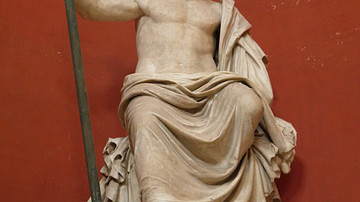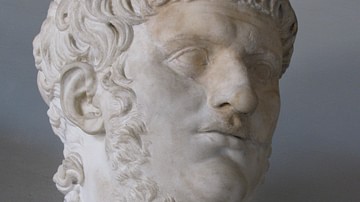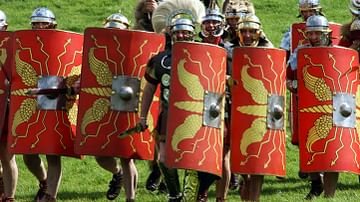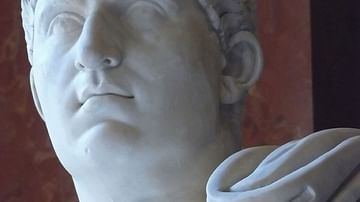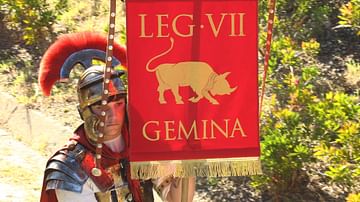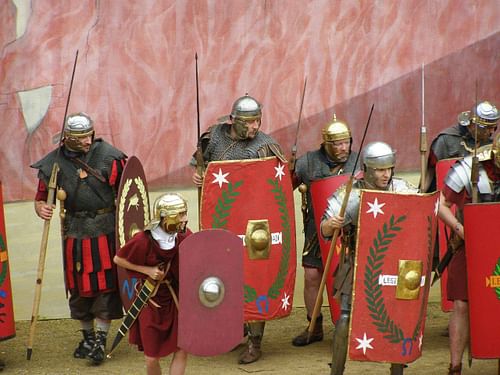
Legio I Adiutrix was a legion of the Roman army formed from veteran sailors after the death of Roman emperor Nero (r. 54-68 CE). During its long career, the legion accompanied Trajan (r. 98-117 CE) on his Dacian and Parthian campaigns, fought with Marcus Aurelius (r. 161-180 CE) in his German Wars, supported Septimius Severus in 193 CE, and was still active in the 5th century CE.
Origin
As his enemies closed in on him during his final days on the throne, Emperor Nero was desperate. Although Rome already had two legions in the city — Legio XI Claudia and Legio XV Apollinaris — he decided to form a third legion from the sailors of the Roman navy stationed at Misenum. The sailors were anxious for the opportunity because, like any other Roman legionary, they could now gain Roman citizenship. The would-be legion waited impatiently to be presented with their eagle and standards when Nero’s death in 68 CE brought a new emperor to the Roman Empire, the governor of Nearer Spain (Hispania Citerior), Servius Galba (r. 68-69 CE). The 5,000 sailors took their cause to him, but he was not as receptive as they had hoped.
With his newly formed Spanish legion, Legio VII Gemina, accompanying him, Galba left Spain and in October arrived at Rome. Unfortunately for the new emperor, his long-awaited entry into the city soon turned into turmoil. Three miles outside Rome, Galba and his army were greeted by thousands of Roman citizens, welcoming him to their city. Among the throng of Romans were the sailors who desperately tried to present their case to him. However, he ignored them, refusing to listen, promising to hear their request later. Of course, this was not what the sailors wanted to hear. Preventing others from seeing or hearing the emperor speak, they continued to follow him, shouting their demands. At the Milvian Bridge that crossed the Tiber, the procession stopped. Upon seeing a handful of drawn swords, Galba ordered his cavalry to attack the mostly unarmed men. The result was bloodshed, and his violent arrival would bring him into direct conflict with the Misenum sailors, the Praetorian Guard, and the people of Rome. Roman historian Tacitus (l. c. 56 - c. 118 CE) in his History wrote of Galba’s entry into Rome and the effects it would have afterwards:
His entry into the capital, made after the slaughter of thousands of unarmed soldiers, was most ill-omened, and was terrible even to the executioners. As he brought into the city his Spanish legion, while that which Nero had levied from the fleet still remained. (History I. 6.)
His harsh reaction to the sailors' demands was a clear indication of the emperor’s reputation for cruelty. Historian Suetonius (c. 69 - c. 130/140 CE) in his Twelve Caesars wrote of his sullied reputation and his brutal treatment of the sailors at the bridge:
Stories of Galba’s cruelty and greed had preceded him. ... Galba more than confirmed this reputation on his entry into Rome. He sent back to rowing duty some sailors whom Nero had turned into soldiers, and when they stubbornly insisted on their right to the Eagle and the standards he not only scattered them with a cavalry charge but also decimated them. (249)
Those who survived the brutal attack were immediately put into custody, albeit still demanding their eagle and standards. Plutarch (c. 45/50 - c. 120/125 CE) the Greek philosopher and historian writes of Galba’s entry in a more sympathetic manner; the sailors were viewed as a disorderly rabble.
When he came within five and twenty furlongs or thereabouts of the city, he happened to light on a disorderly rabble of the seamen, who beset him as he passed. These were they whom Nero made soldiers, forming them into a legion. They so rudely crowded to have their commission confirmed, that they did not let Galba either be seen or heard…Galba put them off until another time, which they, interpreting as a denial, grew more insolent and mutinous. (1166)
He added that after seeing drawn swords "… they were soon routed, not a man standing his ground, and many of them were slain, both there and in the pursuit" (1166). Like Tacitus, Plutarch viewed this as an ill omen. Galba "… was looked upon with terror and alarm by any who had entertained contempt of him…" (1166).

Galba was known by many to be heartless. He believed any sign of disobedience or disrespect to be totally unacceptable and a challenge to his authority. He demanded tribute from many of the towns and no longer spent money on extravagant shows such as the gladiator games. After taking the throne, he refused to pay the Praetorian Guard bonuses that had been promised to them. His continued cuts to expenditures, his ill-treatment of the Praetorian Guard, and the massacre at Milvian Bridge brought him into disfavor with those around him, especially the people of Rome. On the increasing hatred of Galba, Suetonius wrote:
…he outraged all classes at Rome; but the most virulent hatred of him smoldered in the army. Though the officers had promised a larger bonus than usual to the soldiers who had pledged their swords to Galba …. he would not honor the commitment, but announced "It is my custom to levy troops, not to buy them." (250)
Formation of I Adiutrix
In southern France, two neighboring cities - Vienne and Lugdunum (modern-day Lyon) - were embroiled in an age-old dispute. Initially, during the final months before Nero’s death, Vienne had remained loyal to the emperor while Lugdunum supported Galba. However, when Nero stationed Legio I Italica in Lugdunum to protect the imperial mint, the city quickly changed its loyalty to Nero, causing Vienne to rethink its position and support Galba. In December of 68 CE, Galba, in an act of clemency, released some of the sailors in custody and formed a new legion in Vienne. He granted the new legion of sailors, Prima Adiutrix, its eagle and standards. The remaining legionaries for I Adiutrix came from Vienne’s citizenry.
The inexperienced legion soon saw its first taste of conflict when Galba’s authority was confronted by Otho. Marcus Otho (r. 69 CE), governor of Lusitania, was a close ally of Galba and considered himself to be the rightful successor to the throne. Galba, however, chose another heir. According to Suetonius, "Disappointment, resentment and a massive accumulation of debts now prompted him [Otho] to revolt" (257). With the military divided in its loyalty, Legio I Adiutrix realized it needed to declare its allegiance. However, it was not to the man who had incarcerated them. Instead, the legion chose the man who would soon become the new emperor, Otho.
Tacitus wrote of that final day when Lucius Piso, the heir-apparent, addressed the Praetorian Guard. Realizing the gravity of the situation, he spoke to them of their need to remain loyal to Galba and added, "We shall give you a donative for your loyalty, as surely as others can give it for your treason" (I. 30). Those legionaries still loyal to Galba were preparing to protect their emperor, but "No confidence was placed in the legion levied from the fleet, which had been enraged by the massacre of their comrades, whom Galba had slaughtered immediately on his entry into the capital" (I. 31). I Adiutrix sided with the Praetorian Guard against Galba. On 15 January 69 CE, a member of Legio XV Apollinaris killed the unpopular emperor, taking the severed head to Otho. However, Otho’s time on throne would be short-lived. It was the Year of the Four Emperors.
Year of the Four Emperors
Upon his ascension, Otho filled the I Adiutrix with the remaining survivors of the Milvian Bridge massacre and granted the new legionaries their citizenship. The legion chose Pegasus, son of the Roman sea god Neptune, as its emblem. The legion’s loyalty to Otho was soon put to the test. The legions of the Rhine frontier have already given their support to the governor of Lower Germany (Germania Inferior), Vitellius. War was inevitable. At the First Battle of Bedriacum, Otho had the support of not only I Adiutrix but also cohorts of the Praetorian Guard, the evocati, and cohorts of Legio VIII Gemina and Legio XIV Gemina. During the battle, I Adiutrix seized the standard of Legio XXI Rapax. Tacitus wrote of the incident:
On the side of Vitellius was the 21st, called the Rapax… On that of Otho was the 1st, called Adiutrix, which had never before been brought into the field, but was high-spirited, and eager to gain its first triumph. The men of the 1st, overthrowing the foremost ranks of the 21st, carried off the eagle. (I. 43.)
Rapax repulsed Adiutrix and killed its legate, Orfidius Benignus. Plutarch wrote of this clash between Vitellius' Rapax ("The Ravenous") and Otho’s Adiutrix ("The Assistant"):
Otho’s men were strong and bold, but had never been in battle before… Otho’s legion charged boldly, drove back their opponents, and took the eagle, killing pretty much every man in the first rank, till the others, full of rage and shame returned the charge. (1180)
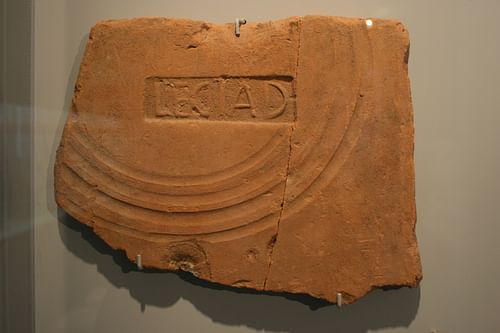
In the end, after reigning only three months, Otho committed suicide, Vitellius marched into Rome as the new emperor, and I Adiutrix was sent to Spain. However, like Otho and Galba, Vitellius would not spend much time as emperor. At the Second Battle of Bedriacum, Vitellius suffered defeat against the forces of Vespasian (r. 69-79 CE). In the battle, I Adiutrix supported Vespasian; its treatment by Vitellius after the first Bedriacum was still fresh in its memory. Tacitus wrote about its role as a leader in the battle:
… the lead was taken in Spain by the 1st legion (the "Adjutrix") whose recollections of Otho made them hate Vitellius; they drew with them the 6th and 10th, Gaul did not hesitate to follow. (III. 44.)
Vitellius was soundly defeated. After only eight months, the dethroned emperor tried to escape Rome in disguise; however, he was captured by Vespasian's legionaries, and while pleading for his life, was dragged through the streets, tortured, killed, and thrown into the Tiber.
Later History
In 70 CE, Vespasian transferred the legion from Spain to Mogontiacum (modern Mainz, Germany) on the Rhine, sharing a fortress with XIV Gemina, and where it fought in the Batavian Revolt against Gaius Julius Civilis. Afterwards, the legion was transferred to Pannonia and stationed at Brigetio (modern Komárom, Hungary). In 86 CE, the legion joined Domitian (r. 81-96 CE) in Dacia battling its king Decebalus and aiding in the Roman victory at Tapae.
Under Trajan, I Adiutrix was one of the legions of the Dacian Wars. In the spring of 101 CE, Trajan marched out of Rome to his first battle against Decebalus. Although there were already four legions stationed in Moesia preparing to cross the Danube into Dacia, Legio I Adiutrix along with legions XIV Gemina, XV Apollonius, X Gemina, and II Adiutrix were on the way to join Trajan. However, it would take a second Dacian War to defeat Decebalus. Remaining loyal to Trajan, the legion followed him into Parthia in 116-117 CE. Although achieving marginal success, Trajan never returned to Parthia after this. His death in 117 CE brought Hadrian to the throne, who chose not to pursue war, opting for peace.
Hadrian transferred the legion to the Danube where it was part of an army that fought with Emperor Marcus Aurelius in his German campaigns, and under the command of the future emperor Pertinax (r. 192-193 CE), it battled against the Marcomanni. After Pertinax’s assassination in 193 CE, the legion accompanied Septimius Severus alongside X Gemina, XIV Gemina Martia Victrix, and II Adiutrix in his march to Rome where he was acclaimed emperor by the Roman Senate. Realizing he must remove any claimants to his throne, the emperor marched eastward with his legions, crossing into Asia Minor where he defeated Pescennius Niger. Having secured his throne against all claimants, Septimius Severus returned to Rome. Later, along with other legions of the Parthian Wars, I Adiutrix participated in his Parthian campaigns.
The legion next appeared in 238 CE where it fought with Emperor Maximinus Thrax (r. 235-238 CE) in the civil wars and his siege of Aquileia in northern Italy. After the assassination of Maximinus and the short-termed barracks emperors Pupienus and Balbinus, Gordian III was declared emperor. The legion joined the new emperor in his war against the Persians in 244 CE. On 25 February 244 CE, Gordian III was killed near the city of Zaitha on the Euphrates River and was replaced by Philip the Arab (r. 244-249 CE). Little else is known of the legion after the death of Gordian III. According to written accounts, the legion was still in existence in the 5th century CE at Brigetio.



